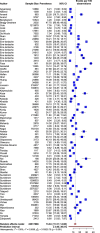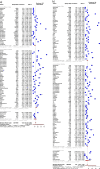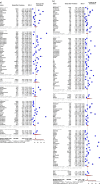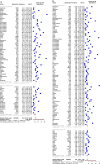Global health inequalities of chronic kidney disease: a meta-analysis
- PMID: 38389223
- PMCID: PMC11483576
- DOI: 10.1093/ndt/gfae048
Global health inequalities of chronic kidney disease: a meta-analysis
Erratum in
-
Correction to: Global health inequalities of chronic kidney disease: a meta-analysis.Nephrol Dial Transplant. 2025 Jun 30;40(7):1442. doi: 10.1093/ndt/gfaf080. Nephrol Dial Transplant. 2025. PMID: 40326367 Free PMC article. No abstract available.
Abstract
Background: Chronic kidney disease (CKD) is a significant contributor to global morbidity and mortality. This study investigated disparities in age, sex and socio-economic status in CKD and updated global prevalence estimates through systematic review and meta-analysis.
Methods: Five databases were searched from 2014 to 2022, with 14 871 articles screened, 119 papers included and data analysed on 29 159 948 participants. Random effects meta-analyses were conducted to determine overall prevalence, prevalence of stages 3-5 and prevalence in males and females. Influences of age, sex and socio-economic status were assessed in subgroup analyses and risk of bias assessment and meta-regressions were conducted to explore heterogeneity.
Results: The overall prevalence of CKD was 13.0% [95% confidence interval (CI) 11.3-14.8] and 6.6% (95% CI 5.6-7.8) for stages 3-5. The prevalence was higher in studies of older populations (19.3% for stages 1-5, 15.0% for stages 3-5) and meta-regression demonstrated an association of age, body mass index, diabetes and hypertension with prevalence of stages 3-5. The prevalence of CKD stages 1-5 was similar in males and females (13.1% versus 13.2%), but the prevalence of stages 3-5 was higher in females (6.4% versus 7.5%). Overall prevalence was 11.4%, 15.0% and 10.8% in low-, middle- and high-income countries, respectively; for stages 3-5, prevalence was 4.0%, 6.7% and 6.8%, respectively. Included studies were at moderate-high risk of bias in the majority of cases (92%) and heterogeneity was high.
Conclusion: This study provides a comprehensive assessment of CKD prevalence, highlighting important disparities related to age, sex and socio-economic status. Future research should focus on targeted screening and treatment approaches, improving access to care and more effective data monitoring, particularly in low- and middle-income countries.
Keywords: CKD; global health; prevalence; systematic review.
© The Author(s) 2024. Published by Oxford University Press on behalf of the ERA.
Conflict of interest statement
R.D., O.A., M.A., E.L., P.D. and N.D. report no conflicts of interest. S.B. reports consultancy fees from AstraZeneca, Bayer and GSK.
Figures










References
Publication types
MeSH terms
LinkOut - more resources
Full Text Sources
Medical

